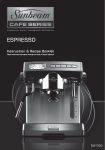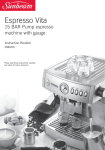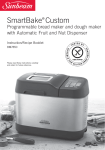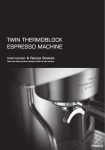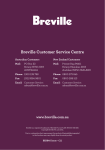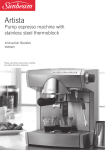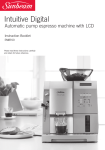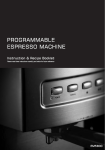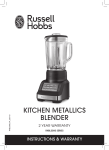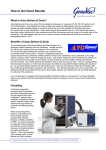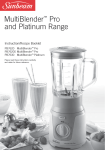Download Waiting on Front Cover from Energi
Transcript
Waiting on Front Cover from Energi Contents Sunbeam's Safety Precautions 2 About espresso coffee 3 Features of your Café Series® Espresso Machine 4 Using the control panel 10 Reference guide to using your espresso machine 13 Programming your espresso machine 20 Preparing your espresso machine before use 22 Guide to the perfect espresso 23 Guide to milk texturing 25 Using the hot water dispenser 26 Espresso recipes 27 Care and cleaning 29 Cleaning the group head 30 Descaling 32 Advanced programming options 34 Important instructions – retain for future use. Sunbeam’s Safety Precautions therefore avoid any direct contact with the SAFETY PRECAUTIONS FOR YOUR steam wand or hot water tap. SUNBEAM ESPRESSO MACHINE • Always disconnect the plug from the power • Always place the unit on a flat, level surface. outlet prior to cleaning the espresso machine • Do not operate without water in reservoir. or if there is any problem during the coffee Fill reservoir with only clean and cold water. making process. Observe the maximum filling volume is 3 litres. • Do not allow the power cord to come into • Do not remove the filter handle during the contact with the hot parts of the espresso espresso pour or water flow as the unit is machine, including the cup warming plate, hot under pressure. Removing the filter handle water tap and steam wand. during either of these operations can lead to a • Do not place hands directly under the steam, scalding or injury. hot water or coffee pour as this can lead to a • The steam wand and hot water tap become scalding or injury. very hot during texturing milk and water flow. This may cause burns in case of contact, Sunbeam are very safety conscious when • Do not use an appliance for any purpose other designing and manufacturing consumer products, than its intended use. but it is essential that the product user also • Do not place an appliance on or near a hot gas exercise care when using an electrical appliance. flame, electric element or on a heated oven. Listed below are precautions which are essential Do not place on top of any other appliance. for the safe use of an electrical appliance: • Do not let the power cord of an appliance hang • Read carefully and save all the instructions over the edge of a table or bench top or touch provided with an appliance. any hot surface. • Always turn the power off at the power outlet • For safety reasons and to avoid maintenance before you insert or remove a plug. Remove by by unskilled persons, some appliances are grasping the plug - do not pull on the cord. ‘sealed’ using tamperproof screws. Such • Turn the power off and remove the plug appliances should always be returned to the when the appliance is not in use and before nearest Sunbeam Appointed Service Centre for cleaning. adjustment or repair if required. • Do not use your appliance with an extension • Do not operate any electrical appliance with a cord unless this cord has been checked and damaged cord or after the appliance has been tested by a qualified technician or service dropped or damaged in any manner. If damage person. is suspected, return the appliance to the nearest Sunbeam Appointed Service Centre for • Always use your appliance from a power examination, repair or adjustment. outlet of the voltage (A.C. only) marked on the appliance. • For additional protection, Sunbeam recommend the use of a residual current • Close supervision is necessary when your device (RCD) with a tripping current not appliance is being used near children or infirm exceeding 30mA in the electrical circuit persons. supplying power to your appliances. • Never leave an appliance unattended while in • Do not immerse the appliance in water or any use. other liquid unless recommended. • Young children should be supervised to ensure that they do not play with the appliance. If you have any concerns regarding the performance and use of your appliance, please visit www.sunbeam.com.au or contact the Sunbeam Consumer Service Line. Ensure the above safety precautions are understood. About espresso coffee Congratulations on the purchase of your Sunbeam Café Series® Espresso Machine. The Sunbeam Café Series® delivers quality, style and superior performance capturing the essence of the commercial kitchen. Inspired by heavy-duty equipment found in restaurants, cafés and bars, the Sunbeam Café Series® is built to last. It brings together a range of appliances designed to expertly create authentic café food and beverages at home. Uncompromising blends of stainless steel, brass and die-cast alloy characterise the range. This combined with advanced technology and functional design, guarantee the performance, that each product will surpass expectations. The Sunbeam Café Series® Espresso Machine features a twin pump, twin thermoblock, TPTT™ system to ensure a stable water temperature while also allowing simultaneous production of espresso and steam to texture milk. The dedicated twin thermoblock heating system takes away the waiting time for water temperatures to change between pouring espresso and producing steam. The twin pumps enables the coffee maker to deliver instant steam for texturing milk and at the same time produce a serve of espresso just like a commercial machine. Another feature of the espresso machine is the progressive pre-infusion. The pre-infusion gradually releases water pressure pre-soaking the coffee grinds before full water pressure is applied. This in turn delivers greater body and sweetness to the espresso. The Café Series® Espresso Machine is designed with quality die-cast metal components and includes many features that make producing delicious espresso at home even easier. We hope you enjoy your new espresso machine and should you need any further assistance please don’t hesitate to contact the Sunbeam Coffee Hotline on Free Call 1800 025 059. Features of your Café Series® Espresso Machine Warming plate The large warming plate effectively prewarms cups helping to retain the essential characteristics true of espresso - sweet, rich tasting and aroma. Variable steam control dial Steam wand A dedicated thermoblock and pump provide an instant supply of powerful dry steam for achieving silky, dense and rich milk. The commercial 360° ball joint allows the steam wand to be moved into the ideal position. Commercial size group head Commercial size group handle Espresso gauge The gauge measures the resistance to the espresso pour. Removable drip tray and grill The large capacity die-cast metal drip tray is lined with plastic, preventing staining from espresso oils, lightweight for easy removal and designed with no dirt traps for simple wipe down cleaning. Height adjustable rubber feet The height adjustable feet ensure the espresso machine is level on the benchtop. Additionally integrated into the two back feet are rollers, these allow the user to effortlessly move the machine – great when trying to clean underneath. Single filter basket Double filter basket Programmable control panel An easy to use control panel provides the choice of manual operation or utilising the programmed espresso pour lengths. Hot water control dial Hot water wand Dispenses a controlled flow of hot water. For ease of use the wand has a commercial 360° ball joint. 3 litre water reservoir Removable 3 litre water reservoir is fitted with an anti-calc filter and hand grips for easy filling. Low water warning indicator Accessories All the essential accessories to make an authentic café-quality espresso – 600ml stainless steel milk texturing jug, barista coffee tamp and spoon for measuring out coffee. Measuring spoon Single pour spout 600ml jug Tamp Single filter basket Dual-floor Double filter basket Dual-floor Cleaning Disc Features of your Café Series Espresso Machine ® Twin Pump and Twin Thermoblock – TPTT™ System Italian designed and manufactured, the machine is fitted with a 15 BAR pump for the espresso function, delivering the pressure required for a complete extraction of oils, coffee solids and aroma. An additional 4 BAR pump is dedicated to the steam function, producing instant steam pressure for texturing milk. TPTT™ System – Simultaneous Use True to commercial use, the unique TPTT™ System features twin pumps and twin thermoblocks, this allows the coffee maker to texture milk and pour an espresso simultaneously. Independent thermoblock heating systems lined with stainless steel, heat the water ensuring the precise temperature is achieved for each function eliminating waiting time and reducing temperature fluctuations. Espresso Gauge The espresso gauge is an indicator of the quality of the espresso pour and should be used as a guide. It measures the pressure or resistance created by water being pumped through the tamped coffee grinds in the group handle. Whilst the needle is within the target area on the gauge it indicates that a quality serve of espresso has been made. This is indicated by a Optimum Pour Under Extracted Pour Over Extracted Pour Features of your Café Series® Espresso Machine continued slow and steady pour of liquid espresso with a consistency similar to that of dripping honey. The crema should be dark golden in colour. Should the needle fail to reach the target area this is an indication that the serve of espresso is ‘under-extracted’. This occurs when water passes too quickly through the tamped coffee grinds and is an indication that either the grind needs to be made finer or the filter basket has been under-dosed. The pour is quick and light in colour and the resulting crema is thin with a creamy light brown colour. Commercial Size Group Head & Group Handle The group head, group handle and filters are designed to commercial specifications using brass and stainless steel components. These elements help contribute to the preparation of an espresso serve, as it allows the coffee maker to pack the necessary amount of coffee grinds, which then expand firmly and evenly onto the shower screen. When the needle goes beyond the target area it is an indication that the serve of espresso is ‘over-extracted’. This occurs when the water passes very slowly through the tamped coffee grinds and is an indication that either the grind is too fine or the filter basket has been over-dosed. In this situation the hot water is in contact with the coffee grinds for too long thus creating a burnt and bitter tasting espresso. This is characterised by the espresso only slowly dripping during the entire pour and the crema is very dark. Features of your Café Series® Espresso Machine continued Filter Baskets Supplied with the espresso machine are two different sets of filter baskets – Standard Filter Baskets (one and two cup) and DualFloor Filter Baskets (one and two cup). The Standard Filter Baskets (one and two cup) are the same specification as used with commercial espresso machines and are less tolerant to the quality of the coffee bean. They have a single floor to the filter and if held up to the light you can see many small holes. Note: For the optimum results Sunbeam recommends that you use these filters with this espresso machine. To achieve the optimum espresso pour with these filters it is best to grind the coffee as you need it. Therefore we recommend a conical burr grinder such as the Café Series® Grinder (Code EM0480) to ensure you have complete control of the particle size and are assured a consistent grind. Note: If you don’t have a grinder and have your coffee beans ground for you, then you must request that the coffee is ground very fine, the same fineness that would be used on a commercial espresso machine. The Dual-Floor Filter Baskets (one and two cup) are designed to be used with preground coffee that is typically available at supermarkets and delicatessens. They have two floors, looking into the filter basket you can see many small holes and when held up to the light and looking at the under-side of the filter you will see a single hole. These pre-ground coffee types are often vacuum packaged into a brick shape and their packaging states that they are a ‘universal grind’ that can be used throughout a variety of coffee makers. The particle size of ‘Universal grind’ is too coarse for making quality espresso, therefore the Dual-Floor Filter Baskets are designed to compensate for this by slowing the flow of liquid espresso creating a subtle aeration to ensure a golden crema. Dual-floor filters or similar designs are used in most domestic espresso machines. Control Panel An easy to use control panel provides the choice of manual operation or utilising the programmed espresso pour lengths. The programmed espresso pour is set to 30mls per cup while the Program function allows users to personalise and save their own espresso volumes. Features of your Café Series® Espresso Machine continued Pre-Infusion Pre-infusion is programmed into the double ‘MANUAL’, single espresso and espresso operations. It is a gradual increase of water pressure pre-soaking the coffee cake before full water pressure is applied. This in turn delivers greater body and sweetness to the espresso. Anti-Calc Filter An Anti-Calc water filter reduces impurities that taint the flavour and odour of the water, improving the taste and aroma of the espresso brewed. Additionally, scale build up is slowed reducing the frequency of cleaning required. The Anti-Calc water filter fitted inside the 3 litre water reservoir has a 12 month life for domestic use and a 3 month life for commercial use. However for those regularly making single cups you may like to remove the two pour spout and fit the group handle with the single pour spout. The pour from the single spout is more defined, evenly transferring the qualities of the espresso into one cup preventing loss of any characteristics during the espresso pour. The two pour spout is securely fixed to the group handle using Loctite™, so removing the two pour spout may be difficult and you will need to use force. To remove the two pour spout use a piece of wooden dowel with a 5mm diameter (or a rigid utensil of the same diameter). Rest it over the top of the pour spouts and then using the dowel as leverage turn it anticlockwise to loosen the pour spout. Note: Contact Sunbeam on 1800 025 059 for replacement filters (Part code: EM69101). Note: The espresso machine can operate normally without the filter and is easily removed by gently pulling it out. Single & Double Pour Spouts Supplied with the espresso machine are two pouring spouts – Standard two pour spout and a single pour spout. Your espresso machine group handle will come fitted with the standard two pour spout for making two coffees simultaneously and for most coffee makers this is ideal. Alternatively, protect the pour spout with a cloth and two pieces of thin wood on either side. Gently secure the pour spout in a vice. Slowly loosen the pour spout from the group handle. Once loosened use your hand to completely remove. Then simply screw on the single pour spout until it is firmly tightened. Using the control panel Power Press the ‘POWER’ button once to turn the espresso machine on. The light above the ‘POWER’ button will illuminate green and start flashing; this is to indicate that your espresso machine is on and is heating up. Important: Once the manual operation is activated, before the espresso pour starts the pre-infusion feature will release three short bursts of gradual water pressure onto the coffee cake. After this the full water pressure is applied and the espresso will pour freely. Note: When the coffee maker has activated the manual operation the lights above the single and double espresso buttons will go off. The lights above the ‘POWER’ and ‘MANUAL’ buttons will remain on. Note: Before turning on the espresso machine ensure that the steam and hot water control dials are in the OFF position. When the green light above the ‘POWER’ button stops flashing and turns to a constant red light, this indicates that the espresso machine is heated and ready to use. The lights above the ‘MANUAL’, single and double espresso buttons will also show a constant green light. To turn the espresso machine off, simply press the ‘POWER’ button, the red power light and all other lights on the control panel will turn off. Manual The ‘MANUAL’ button allows the coffee maker to have complete control over the length of the espresso pour. Once the espresso machine is switched on and heated, so the light above the ‘POWER’ button is red and the lights above the ‘MANUAL’, single and double espresso buttons show a constant green light, the coffee maker is able to use the manual operation. The coffee maker simply needs to press to the ‘MANUAL’ button once to start the pour and again to stop. 10 Single Espresso The single espresso function removes the guesswork and is programmed to pour 30mls of liquid espresso. Tip: We recommend using the single cup filter when using the programmed single espresso operation. Once the espresso machine is switched on and heated, so the light above the ‘POWER’ button is red and the lights above the ‘MANUAL’, single and double espresso buttons show a constant green light, the coffee maker is able to use the single espresso operation. The coffee maker simply needs to press the single espresso button once to start and the pour of liquid espresso will stop automatically. Important: Once the single espresso operation is activated, before the espresso pour starts the pre-infusion feature will release three short bursts of gradually increasing water pressure onto the coffee cake. After this the full water pressure is applied and the espresso will pour freely. Using the control panel continued Note: When the coffee maker has activated the single espresso operation the lights above the ‘MANUAL’ and double espresso buttons will go off. The lights above the ‘POWER’ and single espresso buttons will remain on. Note: The coffee maker does not need to press the single espresso button again to end the pour as the espresso machine will stop automatically. Important: Once the double espresso operation is activated, before the espresso pour starts the pre-infusion feature will release three short bursts of gradually increasing water pressure onto the coffee cake. After this the full water pressure is applied and the espresso will pour freely. Note: When the coffee maker has activated the double espresso operation the lights above the ‘MANUAL’ and single espresso buttons will go off. The lights above the ‘POWER’ and double espresso buttons will remain on. Note: The coffee maker does not need to press the double espresso button again to end Once the pour of liquid espresso stops the espresso machine is ready to make another espresso. Note: When using the single espresso operation you can stop the pour of espresso at any time by pressing the ‘MANUAL’, single, or double espresso operation buttons. Double Espresso double espresso function removes The the guesswork and is programmed to pour 60mls of liquid espresso. Tip: We recommend using the double cup filter when using the programmed double espresso operation. Once the espresso machine is switched on and heated, so the light above the ‘POWER’ button is red and the lights above the ‘MANUAL’, single and double espresso buttons show a constant green light, the coffee maker is able to use the double espresso operation. The coffee maker simply needs to press the double espresso button once to start and the pour of liquid espresso will stop automatically. the pour as the espresso machine will stop automatically. Once the pour of liquid espresso stops the espresso machine is ready to make another espresso. Note: When using the double espresso operation you can stop the pour of espresso at any time by pressing the ‘MANUAL’, single, or double espresso operation buttons. Program The program function allows the coffee maker to personalise and save their own espresso pour settings. Note: Refer to the section ‘Programming your espresso machine’ for simple to follow instructions. 11 Heading Using the control panel continued Once the espresso machine is switched on and heated, so the light above the ‘POWER’ button is red and the lights above the ‘MANUAL’, single and double espresso buttons show a constant green light, the coffee maker is able to use the program function. To activate the program function, the coffee maker simply needs to press ‘PROGRAM’ button. Note: When the coffee maker has activated the program function the light above the ‘PROGRAM’ button will show a constant red light and the light above the ‘MANUAL’ button will go off. Additionally the lights above the ‘POWER’, single and double espresso buttons will remain on. Note: For more detailed information on programming refer to page 20 ‘Programming your espresso machine.’ 12 Reference guide to using your Heading espresso machine The diagrams below and on the following pages are to assist you in operating your Café Series® Espresso Machine. Throughout the instruction booklet reference will be made to these diagrams, so each of them has been numbered for convenience and ease of use. For example: Fill the water reservoir (1) (2) (3) (4) (5) with cold tap water….. Each time you see these numbers please refer back to these diagrams. Preparing the espresso machine 1 Open lid of water reservoir. 4 Remove water reservoir. 2 Fill in place with cold water, OR 3 Open rear door to access reservoir 6 5 Fill at sink with cold water. Press 'POWER' button to turn unit on. Double filter basket Single filter basket 7 Control panel lit and ready to use. 8 9 Warming the espresso cups. Select appropriate filter and place into group handle. 13 Reference guide to using your espresso machine continued 10 Place group handle onto group head. 11 Turn group handle to the right so it is firmly locked into position. 12 Place large container under both pouring spouts. Making the espresso 13 Press the 'MANUAL' button and allow the water to run through. 16 Place finely ground coffee into filter basket. 14 14 Select appropriate filter and place into group handle. 15 Hold group handle under group head and purge with water to preheat. 18 17 Tamp the coffee. The level of coffee must be 3mm below the filter basket rim. Wipe the edge of filter to remove any coffee grinds. Reference guide to using your espresso machine continued 20 19 Place group handle onto group head. Turn group handle to the right so it is firmly locked into position. 22 Press 'MANUAL' button for a continuous pour. 21 Place glasses/cups below pouring spouts. 23 Press the button for a single serve of espresso. 24 Press the button for a double serve of espresso. Programming Double filter basket Single filter basket 26 25 Remove group handle by turning to the left. Discard the used coffee grinds. 27 Fit the group handle with appropriate filter basket. 15 Reference guide to using your espresso machine continued 28 Fill with finely ground coffee. Tamp the coffee grinds. 31 Turn group handle to the right so it is firmly locked into position. 30 29 Place group handle onto group head. 32 Press the 'PROGRAM' button. 33 Press the single espresso button to start and end the pour. Texturing milk 35 34 Press the double espresso button to start and end the pour. 16 Purge the steam wand by turning dial clockwise. 36 Turn off steam by turning dial anti-clockwise. Reference guide to using your espresso machine continued 37 Swing steam wand to the side of espresso machine. 38 39 Place steam wand into milk, approx. 1cm below surface and activate the steam function. Angle jug to rest steam wand on spout and place nozzle just below surface of the milk. 40 Close the steam by turning dial anti-clockwise. 41 Wipe steam nozzle and wand with damp cloth. Hot water 42 Place cup under hot water nozzle and activate the hot water function. 43 Close the hot water by turning dial clockwise. 44 Swing hot water wand over the drip tray. 17 Heading Reference guide to using your espresso machine continued Cleaning 45 Remove the grill. 47 46 Remove drip tray. Wrap steam wand with damp cloth and turn steam on for 10 seconds. Double filter basket 49 48 Insert cleaning pin into the hole, at base of steam nozzle. Remove cleaning disc from inside the rear door. 51 Position cleaning disc inside the double filter basket. 18 50 Fit group handle with the double filter basket. 52 Place cleaning tablet into filter basket with cleaning disc. 53 Place group handle onto group head. Reference guide to using your espresso machine continued 54 Turn group handle to the right so it is firmly locked into position. 55 Place large container under both pouring spouts. 56 Remove group handle from the group head. 19 Heading Programming your espresso machine The Café Series® Espresso Machine has programming capabilities. Based on café settings the single and double espresso functions are set at 30 and 60mls. However by following a few simple steps the coffee maker can personalise the espresso machine to achieve a serve of espresso to exactly how they like it. Programming Single Espresso 1.Prepare the filter handle. Fit the group handle with the single filter basket (27) and fill with finely ground coffee (28). Using the coffee tamp supplied, tamp the coffee grinds (29). Secure the group handle to the group head (30)(31). 2. Place a cup under both pouring spouts. 3.To commence programming press the ‘PROGRAM’ button (32). The light above the ‘PROGRAM’ button will show a constant red light and the light above the ‘MANUAL’ button will go off. Additionally the lights above the ‘POWER’, single and double espresso buttons will remain on. 4.Press the single espresso button once to start the espresso pour (33). The light above the double espresso button will go off and only the ‘POWER’, single espresso and ‘PROGRAM’ lights will remain on. 5.Allow the espresso to pour until the desired level. Once the desired level is reached stop the espresso pour by pressing the single espresso button. 2 beeps will signify that the new setting for the single espresso operation has been programmed and stored into the machines memory. 6.The espresso machine will then return to normal operation mode and is ready to make another espresso at the push of a button. 20 Programming Double Espresso 1.Prepare the group handle. Fit the group handle with the double filter basket (27) and fill with finely ground coffee (28). Using the coffee tamp supplied, tamp the coffee grinds (29). Secure the group handle to the group head (30)(31). 2.Place two cups under each pouring spout. 3.To commence programming press the ‘PROGRAM’ button (32). The light above the ‘PROGRAM’ button will show a constant red light and the light above the ‘MANUAL’ button will go off. Additionally the lights above the ‘POWER’, single and double espresso buttons will remain on. 4.Press the double espresso button once to start the espresso pour (34). The light above the single espresso button will go off and only the ‘POWER’, double espresso and ‘PROGRAM’ lights will remain on. 5.Allow the espresso to pour until the desired level. Once the desired level is reached stop the espresso pour by pressing the double espresso button. 2 beeps will signify that the new setting for the double espresso operation has been programmed and stored into the machines memory. 6.The espresso machine will then return to normal operation mode and is ready to make another espresso at the push of a button. Resetting the Factory Settings To revert back to the original factory settings; 1.Insert the power cord into a 230-240V AC power outlet and switch the power ‘ON’. Heading Programming your espresso machine continued Important: Although the espresso machine is on at the power outlet ensure that the actual espresso machine power is ‘OFF’. Therefore no lights will be illuminated on the espresso machine control panel. 2.Press and hold down the ‘MANUAL’ button. While still holding down the manual button briefly press the ‘POWER’ button and then release the ‘MANUAL’ button. 3.When you hear the 4 beeps and the power light flash the espresso machine will have returned to the original factory settings and the next time the single or double espresso functions are used the espresso pours will be 30 and 60mls. 21 Heading your espresso machine Preparing before use 1.Place the espresso machine onto a dry, stable benchtop. 2.Ensure the drip tray and grill are in place. 3.Fill the espresso machine with water. There are a couple of ways in which the water reservoir can be filled; a) Simply lift the lid of the water reservoir at the top of the espresso machine (1) and using a jug, fill with fresh cold water or filtered water (2). b) Alternatively the water reservoir can be removed and filled with fresh cold water. To do so, open the door on the back of the espresso machine (3) and simply slide out the water reservoir (4). Then fill with fresh cold water or filtered water (5). Replace the water reservoir firmly and shut the door. 4.Insert the power cord into a 230-240V AC power outlet and switch the power on. Press the ‘POWER’ button once to turn the espresso machine on (6). The light above the ‘POWER’ button will illuminate green and start flashing, this is to indicate that your espresso machine is on and is heating up. When the green light above the ‘POWER’ button stops flashing and turns to a constant red light, this indicates that the espresso machine is heated and ready to use. The lights above the ‘MANUAL’, single and double espresso buttons will also show a constant green light (7). 22 Note: Before turning on the espresso machine ensure that the steam and hot water control dials are in the OFF position. 5. Place glasses and cups on the warming plate (8). Important: For first time use or if the machine has not been used for some time, it is important that the machine is rinsed as follows: 6.Fit the group handle with either the single or double filter basket (9). Secure the group handle to the group head (10) (11). 7.Place a sufficiently large container under both pouring spouts (12). 8.Once the espresso machine is switched on and heated, so the light above the ‘POWER’ button is red and the lights above the ‘MANUAL’, single and double espresso buttons show a constant green light, the espresso machine is heated and ready to use. Tip: Remember if the ‘POWER’ light is flashing green, this indicates that the espresso machine is on and is heating up. 9. Press the ‘MANUAL’ button (13) and allow the water to run through until the water reservoir is empty. Note: As a safety mechanism the espresso machine is programmed to automatically stop the water flow after 240mls, therefore you will need to press the ‘MANUAL’ button again to restart the water flow. Heading Guide to the perfect espresso Preheat Glasses 1.Preheat the glasses/cups by filling them with hot water as this will assist to preserve the crema of the espresso. Set the glasses/ cups aside. Preheat Group Handle and Filter Basket 2.Select the appropriate filter basket and place it into group handle (14). Tip: To achieve the best results for a single serve of espresso we advise you attach the single pour spout to the group handle and fit it with the single filter basket. 3.Take the group handle, hold it under the group head and purge water. With the filter basket positioned under the group head press the ‘MANUAL’ button to start the water flow and press it again to stop (15). 4.Dry the filter basket. Dosing and Tamping 5.Using a grinder or the measuring spoon supplied, place the appropriate amount of ground coffee into the filter basket (16). 6.Rest the group handle with the filter basket in position onto the benchtop. Take the coffee tamp, apply firm level packing pressure (17), twisting 90 degrees to polish the grounds. This seals the surface of the coffee cake. 7.Brush any excess coffee grounds from around the edge of the filter basket (18). Important: Be sure to place a sufficient amount of coffee grinds into the filter basket. Once tamped the level of coffee should be only a few millimetres below the rim of the filter basket. To check this, lock the group handle onto the group head (19)(20). Then without having made a coffee remove the group handle (25) and inspect the top of the tamped coffee - it should have only a slight indent from the shower screen. Ideally the top of the tamped coffee should be fractionally below the shower screen and then during the espresso pour the coffee cake will expand up and onto the shower screen. Tip: The coffee dosage and the degree of tamping should remain the same every time you make a coffee the only thing that should vary is the particle size of the coffee grounds and this will vary depending on the bean. For example to achieve a slower espresso pour rate use a finer grind and a coarser grind for a faster espresso pour rate. Note: If purchasing pre-ground coffee or have someone grind it for you, request/purchase a very fine grind, the same that would be used for a commercial epresso machine Tip: Ensure the coffee tamp is dry because if it is wet the coffee grinds will stick to it. The Espresso Pour 8.Lock the group handle onto the group head (19)(20). 9.Empty the glasses/cups and place below the pouring spouts (21). Note: Check to see that the espresso machine is ready for use, remember that if the ‘POWER’ light is flashing green, this indicates that the espresso machine is on and is heating up. 10.Press the required volume button; ‘MANUAL’ for a continuous pour (22), the single espresso for a 30ml pour (23) or the double espresso for a 60ml pour (24). 23 Heading Guide to the perfect espresso continued Note: When using the ‘MANUAL’ operation the coffee maker must press the button once to start the pour and again to stop the pour. However with the single and double espresso operations the coffee maker need only to press these buttons once to start the espresso pour and the program will automatically stop the pour at the preprogrammed level. Important: Should coffee grinds come out from the top of the group handle this is a sign that the group handle has not been firmly locked into position and/or the level of coffee in the basket is too high. Pre-Infusion 11.Once an espresso operation has been activated, before the espresso pour starts the pre-infusion feature will release three short bursts of gradually increasing water pressure onto the coffee cake. After this, the full water pressure is applied to the coffee cake and the espresso will pour freely. 12.Check the espresso pour. The ideal pour starts out dark and then soon after becomes caramel with reddish reflections. The pour should hang vertically on each spout and flow slowly like dripping honey. Tip: The espresso gauge provides an indication of the resistance created by the dosing of the filter basket and the particle size of the grind. Referring to the gauge will be a sign that one or both of these elements may need adjusting. Tip: Once the espresso pour starts to lighten in colour you should cut off the pour. 13.Serve espresso immediately. 24 Caring for your Espresso Machine 14.Remove the group handle from the group head (25). 15. Discard the used coffee grinds from the filter basket (26). Tip: After each use of the espresso machine we recommend that a small amount of water is cycled through the group head as this will wash out any old or used coffee grinds stuck to the underside of the group head. Simply press the ‘MANUAL’ button and allow some water to run through. Sleep Mode After 1 hour of non-use the espresso machine will automatically switch to ‘SLEEP MODE’. An indication that the machine is in ‘SLEEP MODE’ is the light above the ‘POWER’ button will slowly flash red. While in 'SLEEP MODE' the machine powers down to 70% of power. After a further 26 hours of non-use the espresso machine will turn off. Note: To bring the espresso machine out of 'SLEEP MODE' you can press any button. Heading Guide to milk texturing Milk texturing is the steaming of milk. The steam does two things, heats the milk and also the steam mixes air with the milk to form an ‘emulsion’ of tiny bubbles that gives a silky velvet texture. Similar to making an espresso, perfecting the art of milk texturing takes time and practice. Tip: Remember espresso is the foundation for all espresso-coffee drinks and the milk is the variable. 1. Determine how much milk is needed based on the number of cups being made or the size of the texturing jug. Tip: Keep in mind that the volume of milk will increase or ’stretch’ during the texturing. 2. Pour cold refrigerated milk into a stainless steel jug, between to ²/³ full. Tip: Best results will be achieved by using a clean jug and cold, fresh milk. 3. Purge the steam wand of any water. With the steam wand positioned over the drip tray activate the steam function by turning the steam control dial clockwise as far as it will go (35). Once any water has been purged close the steam by turning the steam control dial anticlockwise (36). 4. Swing the steam wand to the side of the espresso machine (37). 5. Place the steam wand into the milk so that the tip of the steam nozzle is just below the surface of the milk and activate the steam function by turning the steam control dial clockwise as far as it will go (38). 6. Angle the jug so that the steam wand is resting on the spout of the jug and lower the jug until the tip of the steam nozzle is just below the surface of the milk. This will start to create a whirlpool action in the milk (39). Note: How we introduce the air to the milk will determine the consistency of the foam. If we catch large gulps of air the quality of the foam will reflect this by having large bubbles. If we can introduce air to the milk in a controlled gentle fashion indicated by a gentle hissing sound the milk will have a fine aerated bead in the textured foam. 7. As the steam heats and textures the milk, the level of the milk in the jug will begin to rise. As this happens follow the level of the milk by lowering the jug, always keeping the tip of the steam nozzle just below the surface. This will create a slight hissing noise. Tip: The amount of foam required will vary depending on the drinks being made, for example a cappuccino requires more foam than a flat white. 8. Close the steam immediately when the milk is heated to between 60-65°C by turning the steam control dial anticlockwise (40). Tip: The optimum drinking temperature of milk is between 60-65°C and we advise you use a milk thermometer to achieve the correct temperature. It's important to remember that if the milk is not heated long enough the drink will be too cool and if the milk is heated for too long it will start to boil at around 72°C and all texture will be lost. Tip: If you don’t have a thermometer a good indication that the correct temperature has been reached is when the jug becomes too hot to leave your fingers in contact. Important: Do not boil the milk as the texture and taste will be affected. 9. Remove the jug and wipe the steam nozzle and wand with a clean damp cloth (41). 10.With the jug in hand tap the jug on the bench top to release the trapped air bubbles. Agitate the milk as this helps the milk and froth combine for an even 25 consistency. Using the hot water dispenser Heading The hot water dispenser is ideal for preparing long blacks, hot chocolate and filling coffee plungers. 1.Swing the hot water wand to the side of the espresso machine. 2.Place the cup or container under the hot water nozzle and activate the hot water function by turning the hot water control dial anti-clockwise as far as it will go (42). 26 3.Once you have dispensed the required amount of hot water into the cup or container, close the hot water by turning the hot water control dial clockwise (43). 4.Remove the cup or container and swing the hot water wand over the drip tray to catch any drips of water (44). Espresso recipes ESPRESSO (SHORT BLACK) MACCHIATO Espresso is a concentrated, full bodied coffee with a stable layer of cream on top – known as ‘crema’. An espresso is the foundation of all café coffee. Variations are achieved by adding different amounts of milk and froth. Macchiato, Italian for ‘to stain or mark’. Traditionally served as a standard espresso with a dash of milk and a small dollop of froth into the middle of the ‘crema’. • 90mL espresso glass or demitasse cup • 90mL espresso glass or demitasse cup • single or double espresso • single espresso (30-35mL) • marked with steamed milk froth LONG BLACK FLAT WHITE A standard espresso with hot water, served in a regular coffee cup or mug. The hot water is added first so that the ‘crema’ is maintained. Another old favourite, the Flat White is an espresso with steamed milk, served in a regular coffee cup or mug. The layer of frothed milk on top should be 2mm to seal the coffee. • 190mL cup • hot water (to taste) • single or double espresso • 190mL cup • single or double espresso • steamed milk 27 Espresso recipes continued CAFFE LATTE CAFFE MOCHA An espresso with steamed milk, typically served in a glass. The layer of frothed milk on top should be 10mm to seal the coffee. Made in a similar way to a cappuccino but with the addition of drinking chocolate. Simply stir the chocolate into the espresso prior to adding the steamed milk and froth. • 220mL glass or cup • single or double espresso • 190-240mL cup or tall glass • steamed milk • single or double espresso • two teaspoons of drinking chocolate • two-thirds milky coffee, one-third froth CAPPUCCINO CON PANNA This delicious drink is an espresso with steamed milk, topped with creamy froth and a dusting of chocolate. The resulting drink is approximately two-thirds milky coffee, onethird froth. A variation on the original Vienna coffee, this delicious drink is made up of an espresso topped with lightly whipped cream. It can also be dusted with cinnamon or drinking chocolate. • 190-240mL cup • 190mL cup • single or double espresso • single or double espresso • two-thirds milky coffee, one-third froth • lightly whipped cream • dusted with chocolate • dusted with cinnamon or chocolate 28 Care and cleaning The coffee making process involves extracting oils out of coffee grinds to make espresso coffee. Deposits of these oils build up over time and affect the taste of the coffee and operation of the espresso machine. Regular cleaning to remove these oils is essential and will maintain the quality of the coffee the espresso machine produces and result in less maintenance being required. This is easy to do by following a few quick and easy cleaning steps after each coffee making session; Cycle water through the group head, Purge steam through the steam wand, Wipe the steam wand clean with a damp cloth immediately after use, Remove the filter basket from the filter handle and clean away any old coffee oils, and Empty the drip tray and rinse. Important: Never wash any of the espresso machine parts or accessories in the dishwasher. Drip tray and grill Remove the grill and drip tray at regular intervals to empty (45) (46). Clean with water and a little non-abrasive washing up liquid, rinse and dry. Group head, group handle & filter baskets The filter baskets and group handle should be rinsed with warm water after each use and then dried thoroughly. To clean the group head of any old coffee grinds cycle water through and wipe the group head and around the inside rim with a damp cloth. Should the holes in the filter baskets become clogged with coffee grinds use a fine bristled brush to remove them. Also you can use the cleaning pin which is supplied with the espresso machine. The cleaning pin is attached to the cleaning disk, located on the inside of the back door (49). The cleaning pin has two pins at either end - one is labelled 'FILTER' and is the shorter of the two and is for cleaning out the holes in the filter basket. Note: When cleaning the dual-floor filters be sure to check the single hole on the underside of the filter. Group head rubber seal The group head seal is located on the underside of the group head and creates a seal against the filter handle during the espresso pour. Note: During long periods of non-use we recommend that the filter handle not be left attached to the group head as this will reduce the life of the seal. Over time the seal will loose its elasticity and require replacement, depending on use usually every 12 months. Signs that the seal is deteriorating are when the group handle cannot create the necessary seal and steam and or water escapes from around the group head during the espresso pour. Another sign may be when the group handle locks off to the right rather than the front. Note: Contact Sunbeam on 1800 025 059 should you think that the group head seal needs replacing. Please do not attempt to change the seal without first consulting Sunbeam. Cup warming plate, hot water wand and exterior Wipe over the unit with a damp cloth and wipe dry. Do not use abrasives or metal scourers as these will scratch the exterior surface. 29 Care and cleaning continued Steam wand Keeping the steam arm clean is essential to ensure maximum efficiency of the steam function. A build up of caramelised/dried milk on the steam wand will impair the steaming and texturing ability of the espresso machine. Important: Wipe the steam wand clean with a damp cloth immediately after each use and purge a small amount of steam. Should the milk dry/caramelise on the steam wand, simply wrap the wand with a clean damp cloth, turn the steam wand over the drip tray and turn the steam on for approximately 10 seconds (47). With the cloth still on the steam wand leave to soak for about 5 minutes and you will find that after this time the dry/caramelised milk will easily wipe away. Repeat process if still dirty. Important: Never clean the steam wand with an abrasive pad as this will damage the steam wand. Should the steam wand become blocked, supplied with the espresso machine is a cleaning pin. The cleaning pin is attached to the cleaning disk located on the inside of the back door of the espresso machine (49). The cleaning pin has two pins at each end - one pin is labelled 'STEAM' and is the longer of the two. With the cleaning pin insert it into the hole in the base of the steam nozzle (48). Should the steam wand remain blocked unscrew the steam nozzle from the steam wand. Clean the steam nozzle by once again using the cleaning pin then flush under running water. Cleaning the group head Deposits of coffee oils build up over time and affect the taste of the coffee and operation of the espresso machine. Therefore the group head will require regular cleaning. It is recommended that the group head is cleaned at a minimum every 3 months, this will vary depending on the frequency of use. Preparing for the cleaning cycle 1. Remove the water reservoir and rinse clean. To do so, open the door on the back of the espresso machine (3) and simply slide out the water reservoir (4). With fresh water completely fill (5) and replace the reservoir. 2. With the door to the back of the espresso machine still open remove the cleaning disc, located on the inside of the back door (49). 30 Cleaning the group head continued 3. Should the group handle be attached to the group head remove it. Remove the filter basket and rinse both thoroughly under running water and set aside. Note: The lights on the control panel will continue to chase until the cleaning cycle is completed, this will take approximately 10 minutes. 4. Empty and rinse clean the drip tray, then place back into position on to the machine. Note: During the cleaning cycle all other espresso machine operations will be locked until the cleaning cycle is completed. Should the cleaning cycle be accidentally started it can be cancelled by switching the power ‘OFF’ at the power outlet. 5. Fit the group handle with the double filter basket (50). 6. Position the cleaning disc into the double filter basket (51). 7. Place a Sunbeam Espresso Machine Cleaning Tablet (EM0020) into the filter basket that is now also fitted with the cleaning disc (52) and secure the group handle to the group head (53) (54). 8. Place a sufficiently large container under both pouring spouts (55). Starting the cleaning cycle 9. Insert the power cord into a 230-240V AC power outlet and switch the power ‘ON’. Note: Although the espresso machine is on at the power outlet ensure that the actual espresso machine power is ‘OFF’. Therefore no lights will be illuminated on the espresso machine control panel. 10.Simultaneously press and hold down the single and double espresso buttons. While still holding down the single and double espresso buttons briefly press the ‘POWER’ button. As the lights on the control panel start to chase from left to right release the single and double espresso buttons. 11.When the cleaning cycle is completed the lights on the control panel will stop chasing and the espresso machine will beep 4 times. Following this, the lights above the 'POWER', 'MANUAL', single and double espresso buttons will come on, signalling that the machine is ready to use. 12.Remove the container from under the pouring spouts and empty. 13.Remove the group handle from the group head (56). 14.Remove the cleaning disc from the group handle and return to storage position on the inside of the back door. 15.Remove the double filter basket from the group handle and wash in warm soapy water. Rinse well and dry. 16.The espresso machine is now ready for use. 31 Descaling Scale is a surface build up of minerals that naturally occur over time in all appliances that are involved with the heating of water. Therefore the espresso machine will require occasional descaling. It is recommended that the espresso machine is descaled every 4-6 months, this will vary depending on the frequency of use and water hardness. 2.Should the group handle be attached to the group head remove it, rinse thoroughly under running water and set aside. 3.Using a screwdriver unscrew the brewing filter/shower screen from the underside of the group head. 4.Remove and set aside the filter/screen and screw in a safe place. Descaling solution Use any of the following when descaling the espresso machine: Important: Be careful not to lose the filter/screen and screw once you have disassembled the group head. Sunbeam Espresso Machine Descaling Tablets (EM0010) 5.Place a sufficiently large container under the group head. Sunbeam Liquid Descaler (KE0100), or 6.Insert the power cord into a 230-240V AC power outlet and switch the power ‘ON’. Press the ‘POWER’ button once to turn the espresso machine on. Vinegar Solution. Descaling the espresso machine Note: Ensure the espresso machine is turned off and the power cord is unplugged. 1.Remove the water reservoir and rinse clean. Depending on the descaling solution being used use one of the following: A. Sunbeam Espresso Machine Descaling Tablets Fill the water reservoir with 1 litre of warm water and place a descaling tablet into the reservoir. Once the tablet has dissolved replace the reservoir, this takes about 5-7 minutes. B. Sunbeam Liquid Descaler Fill the water reservoir with approximately 1.5 litres of water, add 1 capful of Sunbeam Liquid Descaler and replace the reservoir. C. Vinegar solution Fill the water reservoir with approximately 1.5 litres of warm water, add 3 tablespoons of vinegar and replace the reservoir. 32 Note: Remember if the ‘POWER’ light is flashing green this indicates that the espresso machine is on and is heating up. When the green light above the ‘POWER’ button stops flashing and turns to a constant red light this indicates that the espresso machine is heated and ready to use. Additionally the lights above the ‘MANUAL’, single and double espresso buttons will show a constant green light. 7.Press the ‘MANUAL’ button and allow half the solution to cycle through the group head and then once again press the ‘MANUAL’ button to stop the flow. Important: Do not run descaling solution through the steam wand. Note: As a safety mechanism the espresso machine is programmed to automatically stop the water flow after 240mls, therefore you will need to press the ‘MANUAL’ button again to restart the water flow. Descaling continued Note: Depending on the size of the container under the group head on occasion this may need to be emptied throughout this process. 13.Press the ‘MANUAL’ button and allow the entire water reservoir to cycle through the group head. 8. After half the solution has cycled through press the ‘MANUAL’ button to stop the flow and then press the ‘POWER’ button to turn the machine off. Note: As a safety mechanism the espresso machine is programmed to automatically stop the water flow after 240mls, therefore you will need to press the ‘MANUAL’ button again to restart the water flow. 9. Leave the machine off for 10-15 minutes to allow the descaler solution to take affect. 10.Press the ‘POWER’ button once to turn the espresso machine on. 11.Press the ‘MANUAL’ button and allow the remaining solution to cycle through the group head. 12.Remove the water reservoir from the machine and rinse thoroughly under running water, ensuring that all traces of the descaling solution is removed. Fill with clean water and replace the reservoir. Note: Depending on the size of the container under the group head on occasion this may need to be emptied throughout this process. 14.When this is finished remove the container under the group head and give the machine a good wipe over. 15.Carefully replace the brewing filter/shower screen to the group head. Important: Ensure the screw is tightened well. 16.Fill the water reservoir with fresh water and position it on to the machine. 33 Advanced programming options Espresso Thermoblock Temperature The water temperature of this espresso machine has been calibrated to the precise temperature of 92°C at the group head. The temperature of the water at the group head can be modified in increments of 2°C up and down should it be desired. To do this you need to follow the instructions below: 1.Insert the power cord into a 230-240V AC power outlet and switch the power ‘ON’. Note: The light above the ‘ single espresso’ button will remain on and then if you have already re-programmed the temperature of the espresso thermoblock the position of the light will move to one of the other 4 settings indicating the current temperature setting. Note: This light will remain on for up to 5 seconds before automatically returning to the Factory Setting if no action is taken. The espresso machine will then power on and begin heating up. Note: Although the espresso machine is ON at the power outlet ensure that the actual espresso machine power is ‘OFF’. Therefore no lights will be illuminated on the espresso machine control panel. 5.Within 5 seconds press and release one of the buttons below depending on the required temperature adjustment; 2.Press and hold down the ‘ espresso’ button. -2°C = Press the ‘MANUAL’ button single 3.While still holding down the ‘ single espresso’ button briefly press the ‘POWER’ button and release. Note: This activates the programmability of the Espresso Thermoblock Temperature and to signal this, the light above the ‘ single espresso’ button will illuminate, which is the factory setting. -4°C -2°C 4.Release the ‘ 34 Factory Setting +2°C +4°C single espresso’ button. +2°C = Press the ‘ double cup’ button +4°C = Press the ‘PROGRAM’ button -4°C = Press the ‘POWER’ button Note: When you have selected a new temperature setting the light above the button pressed will illuminate and to indicate that the setting has been changed correctly the light will flash and 2 beeps will sound. Note: The espresso machine will then automatically power on and begin heating up. Remember: If you do not select a new temperature setting within 5 seconds the program will return to the Factory Setting and the espresso machine will then power on and begin heating up. Advanced programming options continued Steam Thermoblock Temperature The steam temperature of this espresso machine has been calibrated to deliver a powerful and dry steam for texturing milk. The temperature of the steam can be modified in increments of 5°C up and down should it be desired. To do this you need to follow the instructions below: 1.Insert the power cord into a 230-240V AC power outlet and switch the power ‘ON’. Note: Although the espresso machine is ON at the power outlet ensure that the actual espresso machine power is ‘OFF’. Therefore no lights will be illuminated on the espresso machine control panel. 2.Press and hold down the ‘ espresso’ button. double 3.While still holding down the ‘ double espresso’ button briefly press the ‘POWER’ button and release. 4.Release the ‘ double espresso’ button. Note: This activates the programmability of the Steam Thermoblock Temperature and to signal this, the light above the ‘ single espresso’ button will illuminate, which is the factory setting. -10°C -5°C Factory Setting +5°C +10°C Note: The light above the ‘ single espresso’ button will remain on and then if you have already re-programmed the temperature of the steam thermoblock the position of the light will move to one of the other 4 settings indicating the current temperature setting. Note: This light will remain on for up to 5 seconds before automatically returning to the Factory Setting if no action is taken. The espresso machine will then power on and begin heating up. 5.Within 5 seconds press and release one of the buttons below depending on the required temperature adjustment; +5°C = Press the ‘ double cup’ button +10°C = Press the ‘PROGRAM’ button -5°C = Press the ‘MANUAL’ button -10°C = Press the ‘POWER’ button Note: When you have selected a new temperature setting the light above the button pressed will illuminate and to indicate that the setting has been changed correctly the light will flash and 2 beeps will sound. Note: The espresso machine will then automatically power on and begin heating up. Remember: If you do not select a new temperature setting within 5 seconds the program will return to the Factory Setting and the espresso machine will then power on and begin heating up. 35 Advanced programming options continued Steam Wetness or Steam Pump Rate The steam pump rate of this espresso machine has been set at 0.3 seconds on and 0.5 seconds off. Modifying the steam pump rate enables you to make the steam wetter or dryer and aids in the delivery of a powerful, dry steam - ideal for texturing milk. The steam pump rate (off time) can be modified in increments of plus or minus 0.1 seconds should it be desired. To do this you need to follow the instructions below: 1.Insert the power cord into a 230-240V AC power outlet and switch the power ‘ON’. Note: Although the espresso machine is ON at the power outlet ensure that the actual espresso machine power is ‘OFF’. Therefore no lights will be illuminated on the espresso machine control panel. 2.Press and hold down the ‘PROGRAM’ button. 3.While still holding down the ‘PROGRAM’ button briefly press the ‘POWER’ button and release. 4.Release the ‘PROGRAM’ button. +0.2 sec +0.1 sec Factory off off Setting -0.1 sec -0.2 sec off off Note: This activates the programmability of the Steam Pump Rate and to signal this, the light above the ‘ single espresso’ button will illuminate, which is the factory setting. 36 Note: The light above the ‘ single espresso’ button will remain on and then if you have already re-programmed the Steam Pump Rate the position of the light will move to one of the other 4 settings indicating the current setting. Note: This light will remain on for up to 5 seconds before automatically returning to the Factory Setting if no action is taken. The espresso machine will then power on and begin heating up. 5.Within 5 seconds press and release one of the buttons below depending on the required adjustment; -0.1 sec = Press the ‘ double cup’ button (wet) -0.2 sec = Press the ‘PROGRAM’ button (wetter) +0.1sec = Press the ‘MANUAL’ button (dry) +0.2 sec = Press the ‘POWER’ button (dryer) Note: When you have selected a new pump rate setting the light above the button pressed will illuminate and to indicate that the setting has been changed correctly the light will flash and 2 beeps will sound. Note: The espresso machine will then automatically power on and begin heating up. Remember: If you do not select a new pump rate setting within 5 seconds the program will return to the Factory Setting and the espresso machine will then power on and begin heating up. Advanced programming options continued Factory Reset To undo any changes made to the program you can revert back to the original factory settings. To do this you need to follow the instructions below: 1.Insert the power cord into a 230-240V AC power outlet and switch the power ‘ON’. Note: Although the espresso machine is ON at the power outlet ensure that the actual espresso machine power is ‘OFF’. Therefore no lights will be illuminated on the espresso machine control panel. Note: This resets ALL the program settings back to factory settings, including the program espresso pour volumes, espresso & steam thermoblock temperatures and the steam pump rate. 5.To indicate that you have successfully reset the factory settings the light above the ‘POWER’ button will flash and 4 beeps will sound. Note: The expresso machine will then automatically power on and begin heating up. 2.Press and hold down the ‘MANUAL’ button. 3.While still holding down the ‘MANUAL’ button briefly press the ‘POWER’ button and release. 4.Release the ‘MANUAL’ button. 37 Notes Notes The Sunbeam 5 Year Pump Guarantee Sunbeam has built its’ reputation on manufacturing quality electrical appliances. Our Cafe Series® Espresso Machine is constructed from the highest quality materials. So much so, we guarantee our pump for five (5) years against faulty materials or manufacture. This guarantee is just another expression of our confidence in the way we make appliances at Sunbeam. The Sunbeam five (5) year pump guarantee begins from date of purchase and extends for four years beyond the 12 Month Repair Guarantee. It covers only the pump, guaranteeing it against faulty materials or manufacture. It does not cover damage caused by accident, misuse or being used in a manner not in accordance with the Instruction Book. This guarantee is additional to the conditions and warranties which are mandatory, implied by the laws and regulations of the individual States and Territories of Australia and the Trade Practices Act, 1974. If a fault should develop with the pump after the period covered by the 12 Month Repair Guarantee, then return the Cafe Series® Espresso Machine to any Sunbeam Authorised Appliance Service Centre, together with your receipt. How the guarantee operates: You must fill in your five year Pump Guarantee form and send it to Sunbeam for registration in order to be eligible for this guarantee. Your Cafe Series® Espresso Machine is covered for the first year against faulty material or manufacture, by the Sunbeam 12 Month Repair Guarantee. If you experience any difficulties with your expresso machine within this 12 Month period you should contact our free call customer service line on 1800 025 059 in Australia or 0800 786 232 in New Zealand. The Service Centre will contact Sunbeam to establish that you have registered for the pump Guarantee. Once this has been confirmed the Service Centre will examine the pump and if it is faulty or defective the pump will be replaced free of charge. For a list of your nearest Sunbeam Authorised Service Centres contact Sunbeam on Freecall - 1 800 025 059 or Visit the Sunbeam website www.sunbeam.com.au IMPORTANT NOTE Sunbeam agrees to replace the pump in the event of the pump developing a fault or defect, within the four years after the 12 Month Repair Guarantee. As your Espresso Machine needs to be assessed at a Sunbeam Authorised Service Centre, it will not be accepted through retail stores. Sunbeam reserves the right to refuse to replace a broken or damaged pump in the event that the consumer has had it replaced a number of times, and that it is felt that the Espresso Machine has been misused. If using the Cafe Series® Espresso Machine for commercial use this pump Guarantee is limited to 12 months from the date of purchase. 12 Month Repair Guarantee Should the appliance develop any malfunction within 12 months of purchase due to faulty materials or manufacture, we will REPAIR it for you at no charge. If you experience any difficulties with your espresso machine, please immediately contact our Sunbeam Free Call customer service coffee line. The Free Call number in Australia is 1800 025 059, or New Zealand 0800 786 232. 1 .Your Sunbeam 12 Month REPAIR Guarantee does not cover misuse or improper handling, and excludes breakables, and normal wear and tear. 2. Similarly, your 12 Month REPAIR Guarantee does not cover damage to household surfaces as a result of water or other substances leaking from your espresso machine. 3. It will be at the discretion of Sunbeam whether to repair or replace any espresso machine during the REPAIR guarantee. Sunbeam is by no means obliged to replace any espresso machine if it can be repaired. Sunbeam reserves the right to determine whether or not the espresso machine is irreparable due to any claimed defect caused by faulty workmanship or material. If Sunbeam determines that the espresso machine is irreparable due to the above factors, then Sunbeam will replace the espresso machine. 4. Prior to any REPAIR a purchase receipt to prove date of purchase must by provided for authenticity. 5. This is a REPAIR only guarantee. Sunbeam will not be responsible for the cost or insurance associated for transport to and from any Sunbeam authorized service centre. Similarly Sunbeam will not be responsible for any damage or loss that occurs during transit to or from any Sunbeam authorized service centre. 6. Subject to paragraph 3 above, this REPAIR guarantee does not cover any repairs performed by any un-authorised service centres. 7. This REPAIR guarantee is only available on this espresso machine for domestic use. 8. To the extent permissible by law, Sunbeam will not liable for any incidental or consequential damage, injury or loss (whether material or personal) arising out of any defect of the espresso machine, including but not limited to flooding, fire, injury to persons, or damage to property. 9. This REPAIR guarantee excludes or replaces all warranties and conditions implied by any Australian Federal or State legislation or legislation in New Zealand which may be excluded, restricted or modified under such legislation. Nothing in this guarantee, however, shall be construed as excluding, limiting or in any way affecting any rights you may have under the Trade Practices Act 1974 or any other Australian Federal or State legislation or legislation in New Zealand which give you rights which cannot be modified or excluded by agreement. Sunbeam Authorised Service Centres Should your espresso machine require repair or service, either during or after the guarantee period, please immediately contact Sunbeam and we will direct you to your nearest authorized service centre. To ensure quick service, prepare a note stating your full name and address, and the nature of the complaint, and attach it to your appliance. Pack your appliance carefully in a strong carton surrounded by newspaper or other supportive packing material to prevent damage. Clearly address it to the selected service centre, and include your name, address and phone number on the outside of the package. Consumer Hotline Australia 1800 025 059 New Zealand 0800 786 232 www.sunbeam.com.au ‘Sunbeam’, is a registered trademark of Sunbeam Corporation. Sunbeam ‘Cafe Series’ logo and words ‘Cafe Series’ are trademarks of Sunbeam Corporation Made in China. Designed and engineered in Australia. Due to minor changes in design or otherwise, the product may differ from the one shown in this leaflet. Backed by Sunbeam's 12 Month Repair Guarantee and National Service Network. © Copyright. SUNBEAM CORPORATION LIMITED 2006. ABN 45 000 006 771 Sunbeam Corporation is a division of GUD Holdings Ltd. 09/06













































